Roger and Matthew Smith’s magnificent ewe hoggets, scanned 141 %, story later.
Wairere Romneys put a distinctive stamp on their progeny around the world, in New Zealand, Australia, UK, Ireland, France, Germany, Chile.
Example: Jim Logan in Scotland has saved £100,000 in winter feed costs by changing to outdoor sheep year round, and adopting Trevor Cook’s advice on subdivision and rotational grazing. Jim’s lamb survival is 95% of lambs scanned.
The new season is shaping up to be a bonanza! Store lamb farmers might average $120 for lambs at weaning, and $150 plus for cull ewes. Wool has risen more than a dollar per kg.
The supply/demand balance will continue to work in our favour, given the fast increasing area of farmland being converted to pine trees or lifestyle blocks. While this land has been going out of sheep and beef, more stock have been killed, but even that isn’t maintaining New Zealand’s export tonnage of sheep meat. The sheep breeding population is falling fast.
As in New Zealand, the UK government is subsidising the planting of trees. Trees will take over much of the marginal farmland in Wales, Scotland and northern England. One prediction is that sheep numbers in the UK will fall from 14 to 8 million over the next decade.
World demand? Meanwhile the world demand for meat continues to increase, predicted to rise from around 346 million tonnes in 2018 to 370 million tonnes in 2030, a 16% increase. If you believed the media in New Zealand, the world is converting to vegetarian diets, bicycles, and walking to work and school. It hasn’t happened yet.
The decade 2011–2021 has been the most profitable for NZ sheep and beef per hectare returns since the 1970s. This decade is starting on a high note.
The future of sheep?
When I was in the UK thirty years ago, I was told that a lamb carcass was too small to be profitable. NZ frozen lamb had tracked the price of pork for decades. Wool prices were in sharp decline. Tim Tatham, then a director of Affco, was on a mission to achieve $30 at the farm gate for a 16kg lamb. The national lambing percentage was around 100, and average lamb weight was around 14kgs.
Where are we at now? National lambing is 130% and average lamb weight is 19kgs.
What does Wairere target now?
- Many commercial breeding farmers have reached a lambing percentage which fits with feed supply. Higher lambing percentages need higher growth rate to convert triplets into profit.
- Faster growth of lambs continues to be a target at Wairere, on permanent hill country pastures up to 140 years old.
- Thick skin, survival at lambing – Wairere is an ideal environment to select for a thick skin, with a high wind chill factor and a wet cold climate. This selection has been ongoing through more than fifty years of free lambing hoggets and ewes. When scanner Matt Farmer measures the eye muscle of Wairere Halfbred ram hoggets in Central Otago, he always comments on the thickness of skin relative to other sheep that he scans. The climate at Wairere is wet cold, more demanding than dry cold.
- Higher intramuscular fat (IMF) doesn’t show up easily on hill country. Instead we focus on constitution, and a type of lamb or hogget which can be grown out to big weights.
What about wool?
There are four ways to go:
- More wool. Three product development initiatives promise a return to a farm gate price above $5 per kg. Wools of New Zealand and Wool Research Organisation New Zealand have publicly launched their initiatives in July. Wools of New Zealand has bypassed middlemen, and has manufactured carpet under contract in Turkey. The reduction in costs enables woollen carpet to compete with synthetic on price.
WRONZ has focused on deconstructing wool to a cellular and particle level and then reconstructing it for various product uses, ranging from cosmetics to printing.
New Zealand Merino has already publicised Keravos, a plastic substitute which uses corn starch and strong wool. A shift from small scale to large scale manufacturing should happen within twelve months. - No wool. Wairere will import hair sheep genetics from the UK this year. This is a large scale program, targeting 400 embryos and 1,000 straws of semen from more than five flocks, several recording with SIL or Signet. Pierre Syben has been in the UK for some months during each of the past three years, selling rams for WairereUK. He has taken that opportunity to check out hair sheep throughout the UK. Pierre has sourced a range of genetics from flocks which lamb hoggets, wean 150% plus, have good growth rate, are structurally sound, and come from wet, cold climates.
- Some wool. At the recent Massey Riverside farm field day on Wiltshire genetics, a long term Wiltshire breeder recommended a composite with a small percentage of Wiltshire genetics, enough to eliminate dagging. Shearing a light fleece once per year is economic if wool price improves, and there is no other work required around wool during the year. Wairere is developing an easycare wool line, some available in autumn 2022.
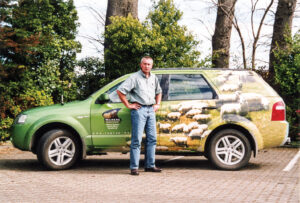
Pierre Syben
4. Finer wool. Wairere has a Halfbred flock in Central Otago. It is possible to use introgression to breed for finer wool: breed Halfbreds to Romneys, then mate 3/4 to 3/4, and a quarter of the progeny will have the genes for finer wool. This is a longer term project, but one that we will investigate.
Wool – In July I visited Flair Flooring Xtra in Carterton to check out the new carpet range from Wools of New Zealand. This initiative is truly exciting, because it replaces the sale of raw fibre with branded product. CEO John McWhirter has hired a strong team to promote the new product range in more than sixty Flooring Xtra stores throughout New Zealand. More new products are under development, with interest offshore as well.
The sales display at Carterton also included an impressive range from Cavalier Bremworth. The salesman said that wool carpet sales have recently moved from 20% to 50%, with synthetic carpet sales declining. Cavalier used to sell a big range of synthetic carpets. The tide is turning.
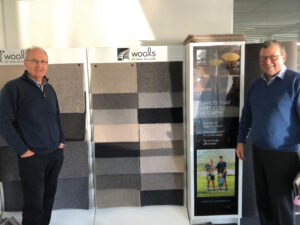
WoNZ CEO John McWhirter and technical manager Dave, with the new range of wool carpets.
Blue sky for wool – I’ve just returned from the launch of the WRONZ pilot plant for new uses in Lincoln, the culmination of a seven year R and D program. This is a transformational project, taking strong wool out of a limited future in textiles to a multitude of potential uses, several of which promise to be high volume as well as high value. It is predicted that the transformation process will be proven by the pilot plant within the next several months. When that is achieved there will be a call for capital to build a plant processing 20,000 tonnes per year. As these various initiatives mature, sheep farmers might find that up to $10 per greasy kg at the farm gate will be a reality in five years time.
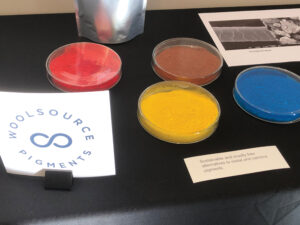
Pelts – The value of pelts has tracked downwards, just like wool. Since January 2019 one large sheep processor has been sending around 40% of sheep pelts to landfill. Pelts used to be an important part of the value of a lamb at the farm gate. But farmers were happy to desert the value chain early, rather than investing to take product as close as possible to the consumer. To commit to consumer focused fashion would require a big commitment from farmers, and a long road to hoe. If farmer-backed wool initiatives work out well, pelts might be the next step.
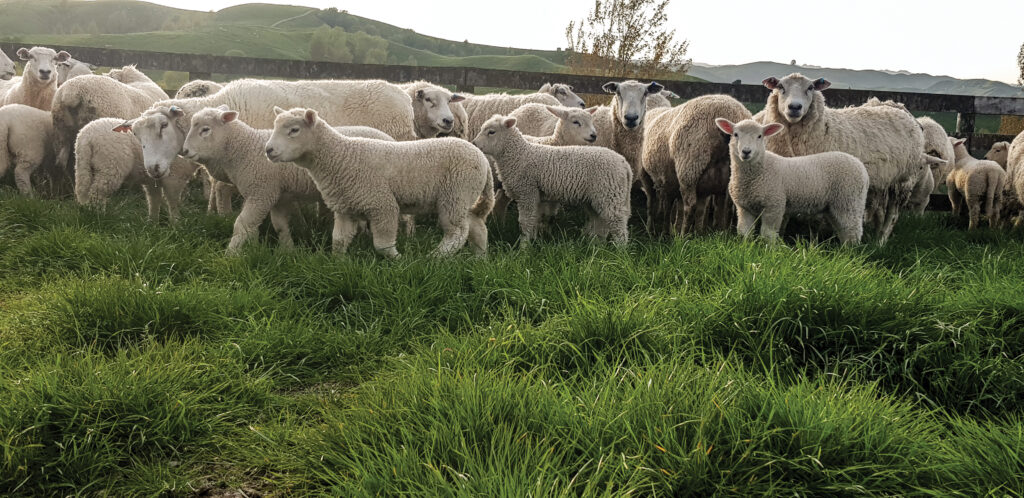
Multiplier ewes at docking 2020.
Despite very dry conditions at tupping, Pakaraka manager Chris Liddle achieved an exceptional scan of 208%. How did he do it? He gave the ewes two hours per day on a kale crop for two weeks, then two weeks full time on the crop, a week either side of the start of mating. The kale crop came in handy in the winter too, coping with 1,200 out of 1,800 ewes on the 400 hectares of summer dry hill east of Masterton. Chris also cut some poplar and willow branches for ewes in late summer.
The Multiplier ewes are open on the points, so Chris gets away with shearing three times in two years, with no crutching and little dagging required. Is this the future for wool?
Wairere King
After 25 years Wairere’s joint venture with Murray and Fiona Gemmell has come to an end. Wairere purchased the Gemmells’ fifty percent early this year. Murray grew a strong base of loyal clients. At Wairere we look forward to doing our best for you. One change will be to truck rams to Whangarei to enable Northland clients to pick their own. Rob Stratton and I visited most Wairere King clients in Northland in April. It was a privilege to visit top farmers, hear their stories, and admire their country and stock. We even went Kiwi spotting one night, and saw eighteen out feeding in the paddocks.
World champions!
Among the Wairere King clients we visited were Murray and Joanne Southee, parents of World Champion cricketer Tim, and Tim’s brother Mark. Murray left school with the goal of wanting to go farming. He took on a career as a fat stock buyer, which lasted forty three years, a job that he really enjoyed. He and Joanne bought 48 hectares in Northland in 1981, because land there was around a tenth of the price in the Waikato. Land was added over time, now 1,000 hectares for sheep and beef, and 400 hectares of dairy farm jointly owned with another family, run by a sharemilker. Murray says, “If there’s a will, there’s a way, to own your own farm… but “starter” farms are now being planted in trees, and there is less farm land available. So it is more difficult today.”
The Southees have been using Wairere rams since 2008. Murray and Mark are now running 2,500 ewes, 150 Angus cows, plus trading big numbers of steers and heifers.
Murray and Mark lamb early, but consistently scan 170% and dock 147-148%. “Lamb weights are 17-18kg average on one farm, 16-17 on another. We don’t grow big lambs in Northland.”
Murray: “Tim is a partner in one of the farms. The team environment around the Black Caps, including management, reminds me of Brian Lochore’s low key approach with Wairarapa-Bush, and then the All Blacks.”

The Southee family, farming in Northland, with the World Cricket Test Championship mace.
Social licence to farm?
Why did NZ get a credit upgrade in February? Mainly because dairy exports rose by 4.5 billion to $19 billion per year in 2019 and 2020, with more to come. Tourism, “our biggest export industry”, contributed nothing to the upgrade or New Zealand’s standard of living over the past seventeen months. Politicians support AirNZ with all its polluting GHG emissions, while blaming animals that evolved ninety million years ago for manmade climate change! It’s a comedy show, but farmers have been cast as the villains. Lobby groups and politicians have cleverly marginalised our sector. How do we put our case?
Our property rights are being whittled away:
- The government is planning to seize land without compensation on the pretext of preserving Significant Natural Areas.
- The “climate change emergency” is used to justify more regulation and control, a soft dictatorship. The reality is that sea level has risen just 22cm over the past 140 years. And mankind’s use of fossil fuels is going to continue until there is an alternative.
Google the reserves of fossil fuels, and you find: Oil, 47 years until we run out. Natural gas, 52 years. Coal, 133 years. New Zealand has 8.5 billion tonnes of accessible coal reserves, yet government policy has mandated against mining a few kilometres from the Huntley power station, and is importing low quality coal from Indonesia!
- GHG emissions. Blaming animals for manmade climate change is a scam! It has been a political convenience. Perhaps global temperature increase is coming from urban heat islands and the heat generated by billions of engines running night and day? Nothing to do with GHGs?
- Water quality: one rule for cities, one rule for farmers. Why? The water quality problem is in the cities.
- Urban and lifestyle blocks cover almost the same area as dairying. Is there no long term thinking about food security or energy security?
- New Zealand is actually a net carbon sink (Steinkamp et al, 2017), because the carbon sequestration of native bush had been vastly underestimated. But this scientific study has been ignored. It doesn’t suit the political narrative. Why don’t our negotiators raise this with the Paris Accord?
- We are told that Maori managed their resources much better than we do today. Really? When missionaries arrived, Maori lived in a constant state of civil war. Despite burning a third of the native bush and making 32 species of bird extinct, they were running out of food. Taro had died out during the mini ice age. The Musket Wars killed an estimated 20,000, a quarter of the population. That’s why they signed the treaty of Waitangi. That’s why they welcomed the missionaries, with their new crops, animals, and technology. The lesson from history is that Maori, an admirably resilient and resourceful race, had hit the wall with food production. Modern New Zealand will also hit the wall, if we allow continual population increase and continually reducing area for farming.
- Why was the live shipment of cattle banned? Why weren’t passenger liners banned after the Titanic sank? What about the Erebus crash? Why is there little publicity about all the people who die because of doctors’ mistakes?
- Government has been obstructive to the temporary employment of overseas staff in dairying, cropping and horticulture. Other wealthy countries allow temporary migrants. What’s the point of losing hundreds of millions of dollars in export income?
- Beneficiary numbers are up to 385,000, one in nine of working age New Zealanders.
What needs to change?
- New Zealand can be described as a $7 trillion housing market with a shrinking real economy.
- Over the past twenty years inflation in the nontradeables sector has been twice that of inflation in the tradeables sector. Exporters are continually gouged by domestic inflation.
- Domestic inflation has created a PONZI Scheme in the price of property, both rural and urban. In 1970 an average salary was $5,000, and an average house was $8,600. Today a median wage is $55,000, and an average house is $820,000.
- The official inflation figure is a mockery of the real cost of living and doing business. Our young people are becoming slaves to debt. The gap between the haves and the have nots is widening fast.
- The Climate Change Commission promotes the ETS, but that hasn’t changed behaviour around the use of fossil fuels. The ETS adds less than 10 cents to every litre of fuel. Does that change behaviour? It has only accelerated the planting of trees. Paying those carbon taxes will be a stealth tax.
- Prices for most of NZ’s agricultural exports are at an all time high. This is disguising the rot in this economy, where a slide in a children’s playground costs $572,000.
- Naive idealism is making New Zealand poorer and more dependent rather than richer and more self reliant.
- How can the farming sector expose the double standards, symbolic gestures and “divide and rule” of current policy?
- Should New Zealand initiate an Environmental Sustainability competition for towns and cities? To win, there will need to be full compliance with sewage and stormwater regulations, and GHG emissions from transport reduced to 50% of 2018 levels on a per capita basis.
Fix this first – For example, plaster board in New Zealand costs six times as much as it does in the UK, because one operator has 94% of the market.These are the issues which government should be tackling, not trying to decimate agriculture. Prediction: after Covid fears ease, there will be a brain drain of young people to live abroad, and the “housing crisis” will be over. Government’s attempts to make a “fairer society” are failing.
The lust for power – We have a government which wants to centralise power across health, education, the environment, the whole economy. Individuals are not to be trusted. What is the outcome?
Resource consents = bribes – A wetland is a “sacred treasure”, even an area of brown water which dries up in the summer, or the soak area for a septic tank. It seems to be an excuse to say NO. And Regional Councils now have to spend money on biodiversity which doesn’t leave enough funding to protect land from flood damage. Where’s the common sense?
Funny how there were no leaky buildings before building inspectors became mandatory.
Grounswell
Meantime, NZ politicians want to reduce agriculture, despite it being one of the few productive sectors in the New Zealand economy:
- Agriculture, which earns most of our foreign exchange.
- Agriculture, which didn’t need any of the $13 billion wage bailout.
- Agriculture, which wasn’t promised a $2.5 billion handout to improve water quality.
- Agriculture, which has kept the economy afloat during Covid.
- Agriculture, which gave NZ a credit upgrade in February.
- Agriculture, which has improved biodiversity over the past forty years.
- Agriculture, helping support 385,000 beneficiaries.
- Agriculture, having to support more and more bureaucrats.
Solutions
- Combine all official and non official farmer groups to form a united front.
- Bring in Chinese contractors to build roads and cheaper housing. Why is New Zealand the highest cost country in the world to build a house? build a bridge? build a road? This is where government’s focus should be, not denigrating farming.
- Remove the subsidies for carbon credits from planting trees.
- Stabilise the New Zealand population now.
- Check out what’s happening in the real world. Norway is twice as wealthy as New Zealand, but continues to search for oil and gas. Four hundred new coal mines are planned to open over the next five years. The use of nitrogen fertiliser, derived from fossil fuels, allows 60% of the world’s population to eat.
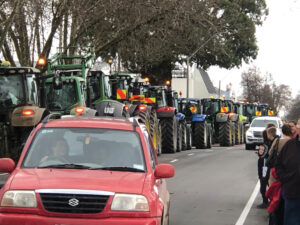
Groundswell Masterton, July 2021. Amazing support! This is a turning point in New Zealand politics
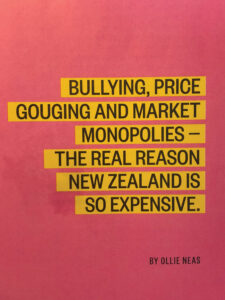
Cover page article in North & South magazine, July 2021.
What’s in your diet?
Prior to joining Wairere as North Island sales manager, Rob Stratton managed 980ha in the Taihape area. He farmed Pukekaka’s 10,500su with one junior shepherd. He did that by keeping a simple system, ewes and cows. Rob lifted productivity with fertiliser, fencing, and Wairere Romney genetics, progressing from 6-7,000 lambs to 9,200 per year. Average weaning weight increased from 28-29kg to 34.5kg at 100 days. Lambing averaged 151% over the last five years, and hogget lambing was in the 65-85% range.
Rob achieved this by focusing on pasture quality. One dramatic move was to use the “spray and pray” technique to change pasture species. One year he sprayed and prayed 25% of Pukekaka!
He was then headhunted by Ballance to help area managers match feed supply and demand for Ballance clients. Here are Rob’s comments:
“Feed budgets are a crucial part of farming so we can answer the question. “Do we have enough grass to sustain our stock through winter and give us the required feed covers to lamb on?” Many budgets look good, some need supplements or Nitrogen. My question is, what sort of grass is on hand, is it high quality with lots of green leaf and clover or is there a high content of stalk and dead matter? Can the ewes process enough grass to get the energy required to achieve the goals that we have set? Do we need to apply Nitrogen? If we do, are we using quantity to hide our quality issues? When we have a surplus the ewe will eat the best grass first, what happens to the rest? Is that the grass we try to flush our ewes on in the Autumn or the feed they have to clean up in the winter?
Measuring the quality of grass (can be done by eye) is just as important as measuring the quantity. Animals can process high quality feed in a relatively short period of time which gives them the ability to consume enough Megajoules of Energy (ME) to grow. Poor quality grass takes a lot longer to digest, has less energy in it, meaning they can’t process enough grass to get the required energy. The younger the animal the more important this becomes, also very important for heavily pregnant ewes where their energy requirements are on the rise from a month prior to lambing.
My next thought goes to grass production, are we optimising grass growth by letting feed go rank or are we better to harvest (eat) grass in it’s green leafy state giving the plant the opportunity to produce more high quality feed?
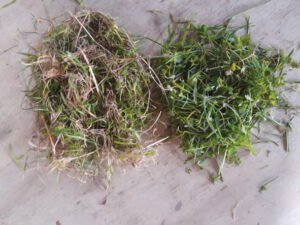
If you grow 7 tonne of Dry Matter (DM) per Hectare per year and harvest it at an average of 9.5 ME per kilogram of DM, you produce 66,500 ME per Hectare per year. By grazing the farm better, can we grow 8 tonne of DM per Hectare per year, eating it at an average of 11 ME would give us 88,000 ME per Hectare per year, a 33% increase in production?
Do we have the infrastructure to achieve this, are there 6 main mobs on the farm being rotated in 30 paddocks (5 each) does that work or has there been a lot of subdivision, simplified the system and only have 3 main mobs and 100 paddocks for the winter rotation? Do we give the grass the opportunity to express itself or do we keep mowing it off every time it pops up?
One size does not fit all and there are many ways of achieving good results. In my experience and what I have had the opportunity to observe is, those that keep their pasture quality through the spring early summer by eating most of what they grow, have the best growth rates on mum and give themselves the opportunity to grow young stock and maintain breeding ewes through the rest of the year with relative ease. Their grass production is not limited and the plant is not trying to put energy into rank feed giving them better autumn and winter grass growth.
Easy to express my thoughts on paper, not so easy to achieve given the many variables in farming. If you can match your feed demand curve with feed supply through the year you’ll go a long way to achieving good results.”
Another success story – photo at top
Roger Smith started buying Wairere Romney rams in 2003, for his 283 hectare farm near Hanmer Springs. Lambing percentage and lamb weights improved rapidly with the change from a Canterbury plains Romney. In 2018 son Matthew decided to leave his agronomist role and return to the family farm. His first change was to lamb the hoggets. That has been a success story, with weaning percentages over 100 to hoggets mated.
In 2019 there were 3,750 lambs sold or retained to 1,830 ewes and 540 hoggets. The dry season in 2020 reduced total lambs to 3,300. Of those, 1,005 were sold prime at weaning at 17.3kg, and the balance finished. Andrew Puddy used to find a home for the surplus ewe lambs, which had to be killed this year in late March at 22kg. So, that’s the secret, growing the ewe lambs very well. Every buyer of the Smiths’ surplus ewe lambs has done really well with them.
Scanning is back on track in 2021, at 188% including triplets, and 141% in the hoggets, with only 37 dry out of 620. Matthew planted 45ha in lucerne two years ago, partially to combat grass grub. He will be trialling other new species to chase a further lift in productivity. Watch this space.
Going for gold
Wairere clients, Brent and Diane Gowler are parents of Kerri and Jackie, standout performers at the Tokyo Olympics. Brent manages for John McOviney, the well known owner of Steelfort Engineering in Palmerston North. Brent first used Wairere genetics at 1,200 hectare Potaka Station in the Manawatu. He achieved a big jump in performance there with Wairere rams. Five years ago, John sold Potaka and bought Taumata Moana Station on the northern King Country coast. The 3,000 hectare property is in full blown development mode, a big project requiring dynamic management, but there has to be family time too. As Brent commented to me recently. “You would also know what it’s like, supporting your kids through the highs, lows and dramas of elite sport. Not easy!”
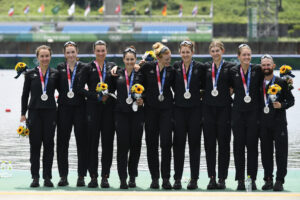
Kerri and Jackie Gowler with the Women’s Eight, silver medals to go with Kerri’s gold in the Pairs. How many families in the world can boast two international Olympic medalists?
Mindset college
Marcus Daniell’s tennis coach, Dave Sammel, wrote the ebook Locker Room Power. Dave says about professional sport, “You only ever have one job, and that is to get better. Find ways to win by keeping your focus on learning. Who says struggle and sometimes winning isn’t the best feeling in the world?” Sounds like ram breeding and farming.
I hope you all enjoy a great season ahead.

Marcus Daniell and Michael Venus won bronze in the men’s tennis doubles.
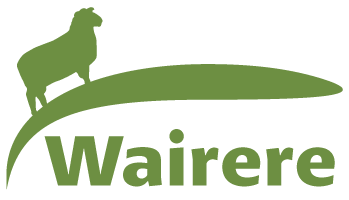
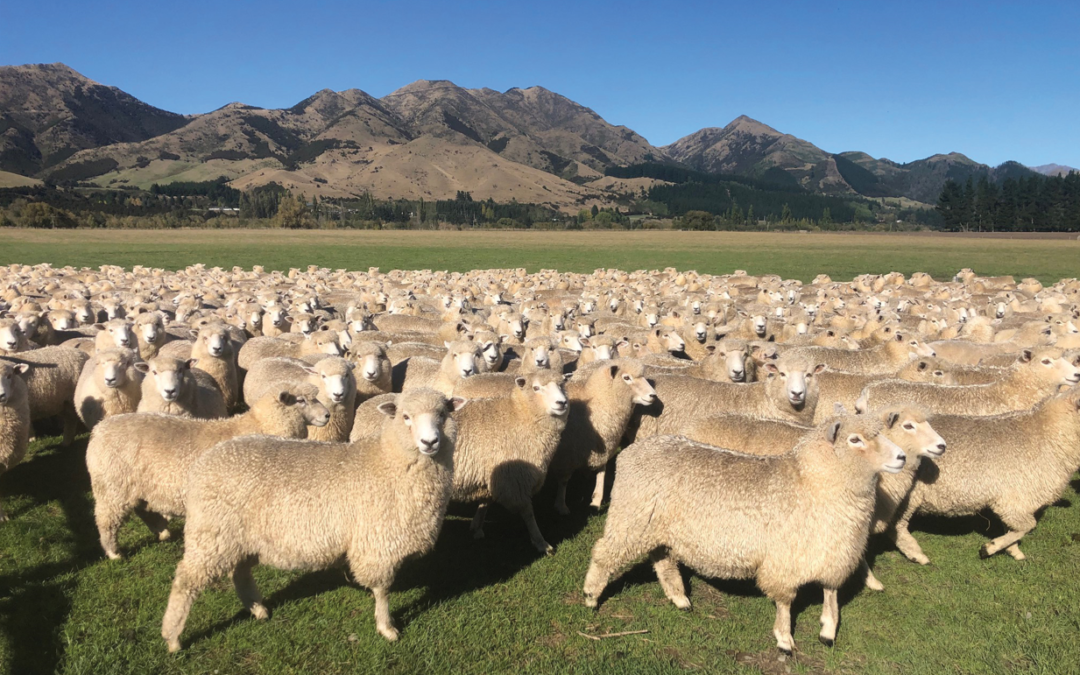
Recent Comments